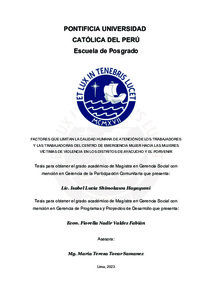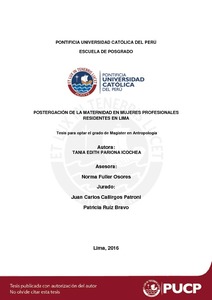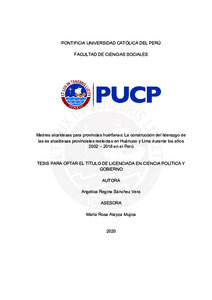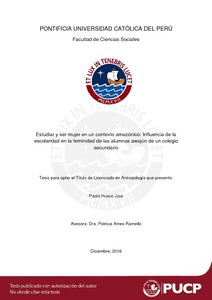| dc.contributor.advisor | Tovar Samanez, María Teresa | |
| dc.contributor.author | Shimokawa Hayayumi, Isabel Lucía | |
| dc.contributor.author | Valdez Fabián, Fiorella Nadir | |
| dc.date.accessioned | 2023-03-16T17:55:11Z | |
| dc.date.available | 2023-03-16T17:55:11Z | |
| dc.date.created | 2023 | |
| dc.date.issued | 2023-03-16 | |
| dc.identifier.uri | http://hdl.handle.net/20.500.12404/24495 | |
| dc.description.abstract | El Estado peruano desarrolla una serie de programas para la no violencia contra
la mujer. En ese contexto nacen los Centros de Emergencia Mujer (CEM),
institución que brinda servicios especializados de atención integral y
multidisciplinaria para personas víctimas de violencia. En el 2012 se atendieron
en los CEM a 42 537 casos de violencia contra la mujer y, en el 2019, 181 885
casos (MIMP: Perú: número de casos atendidos en los centros emergencia mujer
– CEM), esto significa que, en 7 años, la violencia contra la mujer ha aumentado
4 veces sus cifras. Frente a esto nos planteamos la pregunta de investigación:
¿qué factores limitan la calidad humana de atención de los trabajadores y las
trabajadoras del Centro de Emergencia Mujer hacia las mujeres víctimas de
violencia en los distritos de Ayacucho y El Porvenir? El objetivo general de la
investigación es identificar los factores que estén limitando la calidad humana de
atención de los y las trabajadoras del CEM, a través de una investigación
cualicuantitativa, basada en entrevistas y encuestas a autoridades, usuarias del
servicio y a los y las trabajadores del CEM. Para la gerencia social es importante
el estudio del comportamiento y la relación que se teje entre los actores
involucrados en la erradicación de la violencia y en la gestión de políticas que
ayuden a disminuir los indicadores de mujeres víctimas de violencia. Tras la
investigación, se observó que existe una serie de elementos que afectan la
calidad de atención, como la falta de capacitación del personal en habilidades
comunicativas para lograr una buena atención hacia las usuarias y en su poco
conocimiento sobre los derechos de las mujeres; el uso de una comunicación
deficiente entre el personal del CEM y la comunidad, y la atención hacia las
usuarias en un ambiente con mala infraestructura. | es_ES |
| dc.description.abstract | The Peruvian State develops a lot of programs to promote non-violence against
women. In this context the Women's Emergency Centers (CEM) were born, an
institution that provides specialized comprehensive and multidisciplinary care
services for victims of violence. In 2012, 42,537 cases of violence against women
were attended to in the CEMs and, in 2019, 181,885 cases (MIMP: Perú: número
de casos atendidos en los centros emergencia mujer – CEM), this means that in
7 years, violence against women has increased 4 times its figures. Faced with
this, we get he research question: what factors limit the human quality of care of
the workers of the Women's Emergency Center towards women victims of
violence in the districts of Ayacucho and El Porvenir? The general objective of
the research is to identify the factors that limited the CEM workers´ human quality
of care, through qualitative-quantitative research, based on interviews and
surveys of authorities, users of the service and the workers of the CEM. For social
management, it is important to study the behavior and the relationship that is
between the actors involved in the eradication of violence and in the politics that
helps reduce the indicators of women victims of violence. After the investigation,
it was observed that there are a series of elements that affect the quality of care,
such as the lack of training of the staff in communication skills to achieve good
care for the users and their little knowledge about the rights of women; the use
of deficient communication between CEM staff and the community, and attention
to users in an environment with poor infrastructure. | es_ES |
| dc.language.iso | spa | es_ES |
| dc.publisher | Pontificia Universidad Católica del Perú | es_ES |
| dc.rights | info:eu-repo/semantics/openAccess | es_ES |
| dc.rights.uri | http://creativecommons.org/licenses/by-sa/2.5/pe/ | * |
| dc.subject | Violencia contra la mujer--Ayacucho | es_ES |
| dc.subject | Violencia contra la mujer--Perú--El Porvenir (La Libertad : Distrito) | es_ES |
| dc.subject | Mujeres--Trato recibido--Perú--Ayacucho | es_ES |
| dc.subject | Politica social--Perú | es_ES |
| dc.subject | Mujeres--Trato recibido--Perú--El Porvenir (La Libertad : Distrito) | es_ES |
| dc.title | Factores que limitan la calidad humana de atención de los trabajadores y las trabajadoras del Centro De Emergencia Mujer hacia las mujeres víctimas de violencia en los distritos de Ayacucho y El Porvenir | es_ES |
| dc.type | info:eu-repo/semantics/masterThesis | es_ES |
| thesis.degree.name | Maestro en Gerencia Social con mención en Gerencia de la Participación Comunitaria | es_ES |
| thesis.degree.level | Maestría | es_ES |
| thesis.degree.grantor | Pontificia Universidad Católica del Perú. Escuela de Posgrado | es_ES |
| thesis.degree.discipline | Gerencia Social con mención en Gerencia de la Participación Comunitaria | es_ES |
| renati.advisor.dni | 07938272 | |
| renati.advisor.orcid | https://orcid.org/0000-0002-3759-6042 | es_ES |
| renati.author.dni | 45952990 | |
| renati.author.dni | 45260830 | |
| renati.discipline | 314377 | es_ES |
| renati.juror | Trelles Cabrera, Mariela | es_ES |
| renati.juror | Tovar Samanez, Maria Teresa | es_ES |
| renati.juror | Zeballos Velarde, Mauricio | es_ES |
| renati.level | https://purl.org/pe-repo/renati/level#maestro | es_ES |
| renati.type | https://purl.org/pe-repo/renati/type#tesis | es_ES |
| dc.publisher.country | PE | es_ES |
| dc.subject.ocde | https://purl.org/pe-repo/ocde/ford#5.09.00 | es_ES |










